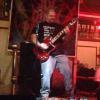First off - yes, you can use Native and a PC or Laptop for live performance. There is nothing stopping you. Helix rack, floor or LT simplifies things, but I've successfully run live with other VST products. Even doing the whole band through a DAW monitored through a PA (Superior Drummer triggered via a electric drum kit, VST's for Vocals, Bass, keyboards and Guitar). Was an experiment at the time, and this was about 5 or 6 years ago. It worked. It did take quite a bit of uplift and testing before the show though.
In a twist, I recently used the Helix Floor as an interface to record the whole band for writing sessions, so while it wasn't a Native plugin, I had a laptop with DAW and was running the drums electric again. That worked great and I didn't have to unmount my recording interface from my studio desk to record the band at my drummers house.
Right now, until I get a Helix LT to backup my Helix Floor, I will use native as an emergency backup rig.
If you want to try this, don't let others discourage you. Test it. Test it again. and again.....
Here are some tips:
SSD in the PC or Laptop helps mitigate vibration and magnetic issues. I use a Surface 3 Pro tablet/laptop now - works great.
Interface - you want to get as little latency as you can. If I were still going live, I'd probably use a full laptop or PC with a firewire or thunderbolt interface. Chipsets matter too, you get what you pay for in that regard.
RAM and CPU Processing Power - again, this helps latency and from glitching. I recommend a newer generation chipset with 8GB RAM.
OS Tweaking - there are plenty of guides for using Windows, Linux or Mac as a DAW for studio - same thing applies live. You don't want updates to kick off in the middle of a show.
Cabling - have everything labeled clearly. Under the dim lights of the local venue with 20 minutes to setup, this becomes essential
Bring a flashlight - see above
Make sure you have a sturdy stand for your laptop. This is the one reason I wouldn't use this setup these days - I play to some very rowdy crowds in small venues.
Have a backup plan.
Again: Testing, testing, testing.
There are some rewards to these kinds of setups. Like live recording and using other VSTs/Plugins to go with Helix Native.
As far as debunking some of the things said here: Price --- most people wanting to use Helix Native already have a DAW setup. I don't think most people that would want to do this would want to build a system from scratch just for live playing. They probably already have most of the components.
Live tweaking - I don't think I've used my Helix Floor once to tweak in the middle of a set. I haven't needed to. I guess it's a nice option to have, but tweaking from a laptop is very easy - and if you are following the testing, testing, testing suggestion, most of the tweaking is done before the show.
Good luck and happy jamming.

